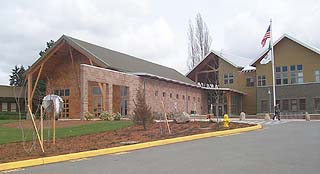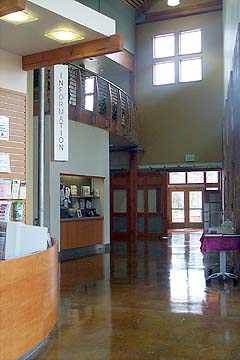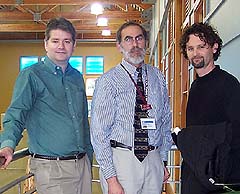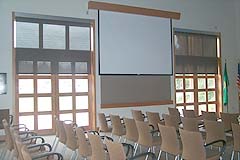|
Subscribe / Renew |
|
|
Contact Us |
|
| ► Subscribe to our Free Weekly Newsletter | |
| home | Welcome, sign in or click here to subscribe. | login |
Architecture & Engineering
| |
April 3, 2002
Serious, modern City Hall, with a friendly barn door
Special to the Journal

Photos by Clair Enlow Lewis Architects' Woodinville City Hall, using bright colors and warm interiors, is an informal expression of a suburban civic structure. |
Woodinville’s new city hall is on a dead-end road, tucked behind a shopping center and a school. But the town is on the move, and a new right-of-way planned next to the project will put the civic center on a through way.
The building was dedicated last spring on the eighth anniversary of Woodinville’s incorporation. And although it is still obscured from one side, Woodinville City Hall invites attention from near and far with its patches of saturated yellow, twin roof ridges, structural outcroppings and masonry walls. At night details of the high interior walls and ceilings glow through the many tall windows.
The first steps toward the creation of a civic center for Woodinville must have raised some interesting questions. How to reflect the character and scale of a quiet, remote suburb while expressing the aspirations of the new city? How to find a good fit and a popular design solution without succumbing to historic replication or residential clichés?
| Woodinville City Hall 17301 133rd Ave. N.E. |
|
Architect:
Lewis Architects: Ross Jamison, principal-in-charge, Laroy Gant, designer, Kim Parsley, interior designer Project size: 24,000 square feet Construction cost: $3.8 million Completion date: March 2001 Landscape Architect: JGM Structural engineer: Dci Mechanical engineer: Rice Group Electrical engineer: Engineered Electrical Systems Cost estimator: Robinson Co. General contractor: Brunner Brothers Construction Jury comments: "This project successfully responded to the requirement for a ‘Northwest woodland character’ in a civic building that is decidedly non-institutional. Although the functional use of the building may not be immediately apparent, it conveys a sense of welcoming and community that seems just right for the new city of Woodinville." "A welcoming, near residential quality invites citizens into this suburban city hall. Materials and colors are used well to make the building attractive. The building may suffer from lack of symbolic qualities as the town grows into a larger community." "This design for a friendly suburban city hall creates an approachable place that's more like a small primary school than a formal civic structure. The bright colors, warm interiors, varied landscaping and casual details have a cheerful presence that fits right in." |
Designed by Lewis Architects, Woodinville City Hall answers those questions with such winning style that it’s hard to remember that small towns have settled for much less. The building combines excitement with warmth and comfort. Visitors are greeted with soaring, exposed structure and visual access to much of the interior. Shifting axes in the plan of the building open circulation areas to the exterior, and generous glazing brings in sweeping views and abundant natural light.
It’s an open and honest building, a serious modern expression with a friendly barn door. According to city manager Pete Rose, it fills the role the city created. "We wanted this to be a poster child for preserving the Northwest woodland character."
The design strategy began with the realization that there wasn’t really a front door on the site, according to Ross Jamison, principal in charge for Lewis Architects. Nor was there a durable context. An undistinguished school house and residential building next door are scheduled to be cleared in the next decade when the city builds a community center.
So instead of taking cues from surrounding buildings, the design grows out of the land itself and defines the development of the future, said designer Laroy Gant.
The plan hinges on a 14-foot-high masonry block wall that anchors the council chambers and runs diagonally through the office wing of the building, reaching between the two main entry points. Breaking continuity twice as it goes, the rosy concrete of the wall divides ceremonial spaces from the administrative areas.
In addition to the prominent masonry wall, exterior materials include stucco above and beveled cedar siding and cedar shingles below. Galvanized metal roofing completes the low-maintenance exterior. Although the building is designed around heavy timber construction methods, laminated wood and thickly molded oriented strand board accommodate cost and environmental concerns. Floors are stained and polished concrete.

High spaces flow together inside the lobby. The second floor overlook provides a view of the counter below. |

Architect Ross Jamison, city manager Pete Rose and architect Laroy Gant. |

The council chamber, which is equipped with a movable dias, opens out to a patio and vast playfield. A "barn door" separates the lobby from the council wing. |
At the heart of the plan is a 35-foot-high lobby corridor with two levels of office space opening to one side and a landscaped courtyard viewed through tall windows on the other.
A small balcony with sculptural rail extends the second level reception area into high lobby space, with its exposed structure. Knowing where to provide an overlook and where to break the view was one of the design problems Gant tested many times in his placement of the interior elements. Two small conference rooms, spread across the ground level of the building, provide the only completely enclosed space for meeting in the otherwise open plan.
"There are no squared-off horse stalls," said Rose, "no area where there is not good access to natural light, or visual access to architectural forms -- and there’s a lot to look at."
The flow between the large interior spaces and between indoors and outside is mediated only by a sliding custom barn door between the entry and council chambers. It closes at night, when meetings convene.
Running through the tall expanse of the lobby is a hard-working concrete counter, a place to lean and talk to city personnel or review a permit. Opposite the counter and against the windows is an equally generous bench for waiting, reading or watching kids follow the sinuous path under the exterior overhang and brackets. Bench and counter bring an intimate scale through the building under the high ceilings and the tall trees outside.
In the year since it opened, the new city building has become a popular meeting place and drawn praise from public officials far and wide.
On summer evenings, the large four-by-eight double stile and rail doors in the council chamber open to the council plaza outside. Beyond these glass-paneled doors, a large playfield stretches to Wilmot Park, the meandering Sammamish River and 175th Street, the commercial spine of Woodinville.
It’s a two-way prospect. The presence of Woodinville City Hall can be appreciated from several points among these landmarks, and the context is also expressed on the site. A meandering path, intended to evoke the course of the nearby Sammamish River, is blasted into the texture of the floor and expressed in the landscape outside as a walkway.
Clair Enlow can be reached by e-mail at clair@clairenlow.com.
Previous columns:
- Tiny Mercer Island chapel solves a small, tricky problem, 03-06-2002
- Temporary library makes a lasting impression, 02-06-2002
- Signature identity on a human scale, 01-09-2002
- Gates Hall uses the past to create a better future, 12-05-2001
- A study in flexibility, 11-07-2001
- Southeast Tower cures several ills at Swedish, 10-03-2001
- Growing Vine Street takes root at 81 Vine, 09-05-2001
- A new model for affordable housing, 08-01-2001


